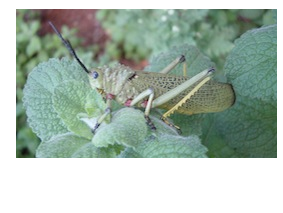Many years ago, at my first teaching job, our Head of Department had planted a wonderful garden in a small space on our small school property, at the bottom of Nugget Hill, in Doornfontein, Johannesburg. Her philosophy was that children should be able to see plants growing. It was a little space we could take the children to, in the concrete jungle, to show them insects and little garden creatures. Our HOD also encouraged us as teachers to pick small bunches of flowers for our classrooms. This has stayed with me throughout my teaching life. I love nature. Sharing this interest with the children you teach, even in the most unlikely teaching environments, shows that it is possible at any school.
We need to teach our children about the little creatures in the garden, encouraging the children to respect them, and discouraging them from hurting or killing these innocent creatures. As a teacher, this is a wonderful teaching opportunity.
The children could be encouraged and motivated to create an indigenous, bird filled, insect and creature friendly environment at school. The enthusiasm may spread to their homes, where they may create their own gardens.
Empower the children to take ownership of the project. The garden area does not have to be big to be effective. Or various garden projects in small areas around the school could be created to attract birds, insects and other little creatures to the gardens. Each class or grade could be given a small area that they would be responsible for.
The children should be encouraged to research and plan the garden carefully before embarking on the project.
Involve the parents as much as possible, invite parents who have knowledge of gardening, nature or garden creatures to speak to the children and inspire them.
Birds:
The children could research and observe which birds are seen near the school. They could research plants which different types of birds eat, such as the flowers or flowers'nectar, seeds or berries.
Once the garden is designed and constructed, bird baths and bird feeders (if needed) could be created for the garden.
Insects:

Children could research various garden insects, learning about them, for example: what plants they are attracted to, the life-cycles of the insects, they could learn how some insects eat other insects.
What about gardening for butterflies, these beautiful creatures are slowly disappearing from our environment. Would it not be wonderful to have a garden full of different butterflies?
The children could research the types of plants to plant to attract butterflies into the garden.
Butterfly-baths could be designed, made and evaluated. A butterfly-bath differs from a birdbath, as a butterfly bath needs to be a tub filled with sand and then water, as the butterflies like to land on very shallow water or wet sand to drink, then the butterfly can stick its proboscis through the sand and suck up the water. The best place to place a butterfly bath is under a dripping tap.
Other creatures:
The children could learn about the other creatures that may live in the garden, such as chameleon, frogs or lizards. They can design, make and evaluate a toad house, using materials such as clay flower pots and acrylic paints to decorate or camouflage and an old shallow pan for water.
The children could take part in a school or grade competition or project to design and plan a school fish pond and surrounding area. The best design could be built according to the children's design and layout.
The teacher or school could make the children aware of projects such as the Southern African Frog Atlas Project (SAFAP), where the sound of the frogs are recorded to assist in a national project, or Birding Big Day, which is the annual Sappi Birdlife Day in South Africa
By relating as much as possible to the child's direct environment, and involving her / him in projects she / he could also mimic what has been learnt at home. Then what we teach as teachers would be having a greater influence on the community.
Enjoy exploring the outdoors with your learners and learning about the wonderful creatures out there.
Extra info:
Interesting Blogs
- Why Natural Insect Control Works better, by Harvey Ussery http://www.motherearthnews.com/organic-gardening/why-natural-insect-control-works-better.aspx
- Attracting butterflies to the garden http://www.hgtv.com/landscaping/attracting-butterflies-to-the-garden/index.html
- Birding Big Day http://www.sa-venues.com/events/southafrica/birding-big-day/
Books to look out for:
- Field Guide to Insects of Southern Africa Authors: Charles Griffiths, Mike Picker, Alan Weaving (also available on Amazon)
- Complete Guide to the Frogs of Southern Africa Authors: Louis du Preez, Vincent Carruthers (2009), it includes a CD of frog calls.
- Newman, K. (1967) "Garden Birds of South Africa" Hortors Printers, RSA. (If you can still get this book, it is simple, informative teaching tool, when introducing children to garden birds.)
iPad Apps to explore:
- iLuvNatureLE - a simple app which shows a limited selection of birds, dragonflies, crickets and frogs. It includes the name of the creature, a picture and the sound it makes. Effective introductory app to use with younger children at school.
- Sasol eBirds - Contains a list of the Southern African birds, with pictures, sounds, location. It is a useful teaching and learning tools
- Roberts VII Multimedia Birds of Southern Africa HD - an effective teaching and learning tools to use in the classroom.
If either of the bird apps are purchased, a school birding list should be compiled.
Websites to look at:
- Frog Atlas Project - just a few more hops before the big splash. http://web.uct.ac.za/depts/stats/adu/pdf/bn11_2p13-16.pdf
- The Southern African Bird Atlas Project 2 http://sabap2.adu.org.za/
- Walter Sisulu National Botanical Garden http://www.sali.co.za/documents/Botanical%20Gardens%20Newsletter.pdf






